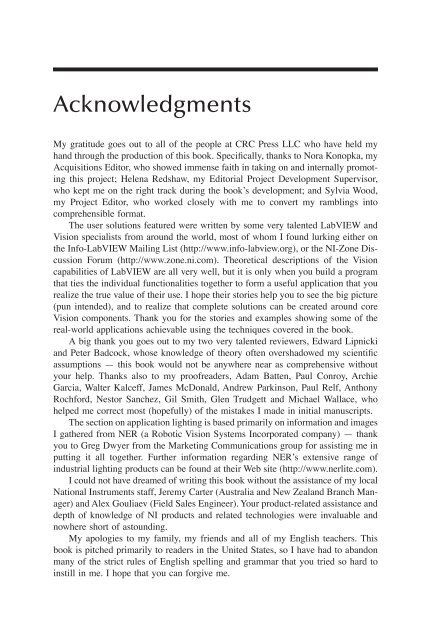Image Acquisitionand Proces
You also want an ePaper? Increase the reach of your titles
YUMPU automatically turns print PDFs into web optimized ePapers that Google loves.
Acknowledgments<br />
My gratitude goes out to all of the people at CRC Press LLC who have held my<br />
hand through the production of this book. SpeciÞcally, thanks to Nora Konopka, my<br />
Acquisitions Editor, who showed immense faith in taking on and internally promoting<br />
this project; Helena Redshaw, my Editorial Project Development Supervisor,<br />
who kept me on the right track during the book’s development; and Sylvia Wood,<br />
my Project Editor, who worked closely with me to convert my ramblings into<br />
comprehensible format.<br />
The user solutions featured were written by some very talented LabVIEW and<br />
Vision specialists from around the world, most of whom I found lurking either on<br />
the Info-LabVIEW Mailing List (http://www.info-labview.org), or the NI-Zone Discussion<br />
Forum (http://www.zone.ni.com). Theoretical descriptions of the Vision<br />
capabilities of LabVIEW are all very well, but it is only when you build a program<br />
that ties the individual functionalities together to form a useful application that you<br />
realize the true value of their use. I hope their stories help you to see the big picture<br />
(pun intended), and to realize that complete solutions can be created around core<br />
Vision components. Thank you for the stories and examples showing some of the<br />
real-world applications achievable using the techniques covered in the book.<br />
A big thank you goes out to my two very talented reviewers, Edward Lipnicki<br />
and Peter Badcock, whose knowledge of theory often overshadowed my scientiÞc<br />
assumptions — this book would not be anywhere near as comprehensive without<br />
your help. Thanks also to my proofreaders, Adam Batten, Paul Conroy, Archie<br />
Garcia, Walter Kalceff, James McDonald, Andrew Parkinson, Paul Relf, Anthony<br />
Rochford, Nestor Sanchez, Gil Smith, Glen Trudgett and Michael Wallace, who<br />
helped me correct most (hopefully) of the mistakes I made in initial manuscripts.<br />
The section on application lighting is based primarily on information and images<br />
I gathered from NER (a Robotic Vision Systems Incorporated company) — thank<br />
you to Greg Dwyer from the Marketing Communications group for assisting me in<br />
putting it all together. Further information regarding NER’s extensive range of<br />
industrial lighting products can be found at their Web site (http://www.nerlite.com).<br />
I could not have dreamed of writing this book without the assistance of my local<br />
National Instruments staff, Jeremy Carter (Australia and New Zealand Branch Manager)<br />
and Alex Gouliaev (Field Sales Engineer). Your product-related assistance and<br />
depth of knowledge of NI products and related technologies were invaluable and<br />
nowhere short of astounding.<br />
My apologies to my family, my friends and all of my English teachers. This<br />
book is pitched primarily to readers in the United States, so I have had to abandon<br />
many of the strict rules of English spelling and grammar that you tried so hard to<br />
instill in me. I hope that you can forgive me.



